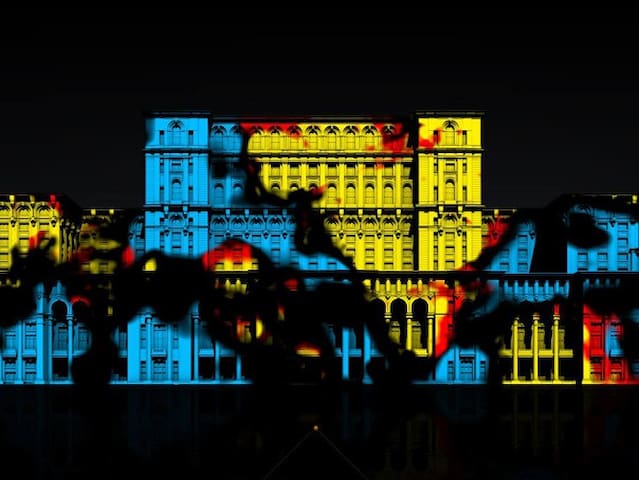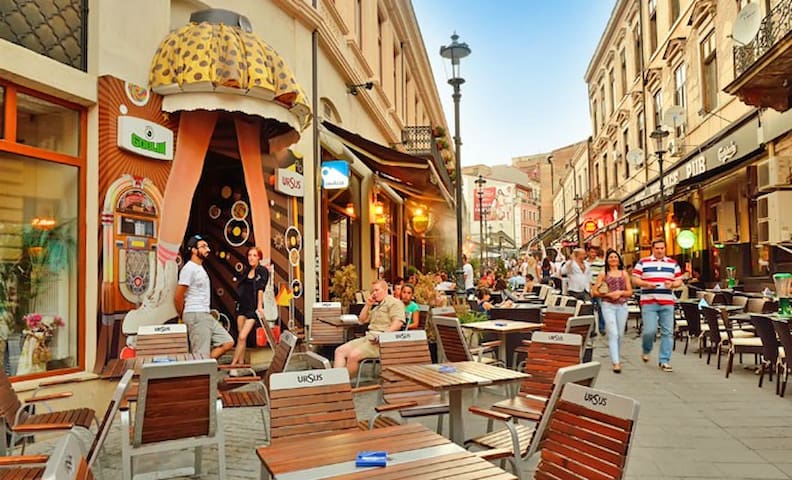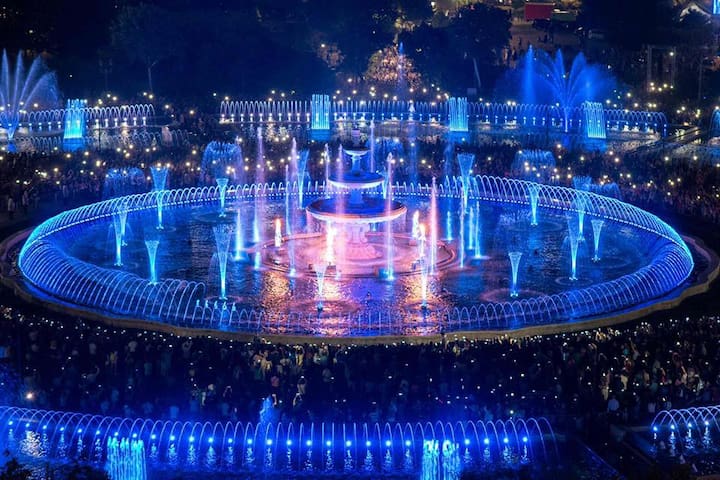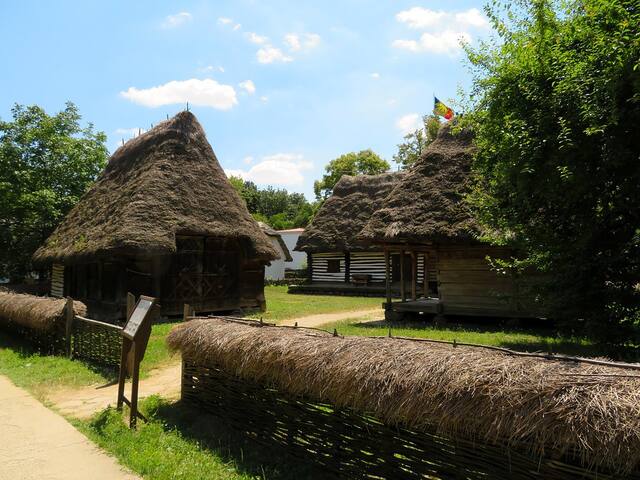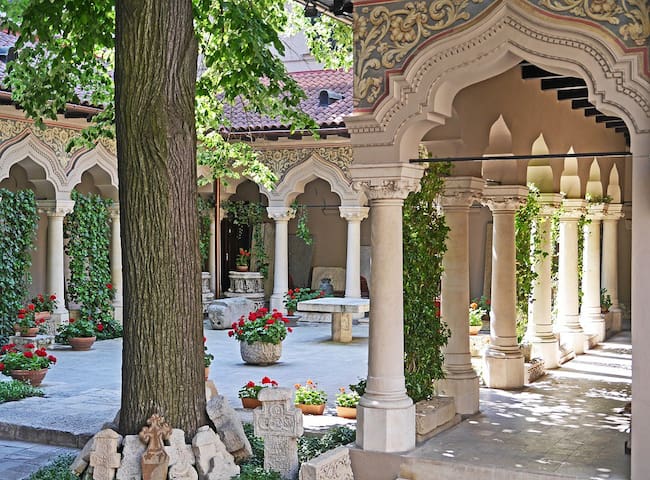Vizitarea obiectivelor turistice
The capital of Romania has lots of charming lanes through the Old Town which will make you discover the history on every step. It’s dynamically growing city as well as important commercial and industrial center. Wandering what is Bucharest famous for you need to know, that between mixture of building from different centuries there are many hidden cafés, forgotten architectural gems on tucked away corners. This makes the city of Bucharest unique.
35 ντόπιοι το προτείνουν
Palatul Parlamentului station
Calea 13 SeptembrieThe capital of Romania has lots of charming lanes through the Old Town which will make you discover the history on every step. It’s dynamically growing city as well as important commercial and industrial center. Wandering what is Bucharest famous for you need to know, that between mixture of building from different centuries there are many hidden cafés, forgotten architectural gems on tucked away corners. This makes the city of Bucharest unique.
The exquisite Athenaeum is the majestic heart of Romania’s classical-music tradition. Scenes from Romanian history are featured on the interior fresco inside the Big Hall on the 1st floor; the dome is 41m high. A huge appeal dubbed ‘Give a Penny for the Athenaeum’ saved it from disaster after funds dried up in the late 19th century. Today it’s home to the George Enescu Philharmonic Orchestra and normally only open during concerts, but you can often take a peek inside.
The peristyle is adorned with mosaics of five Romanian rulers, including Moldavian prince Vasile Lupu (r 1512–21), Wallachian Matei Basarab (r 1632–54) and King Carol I (r 1881–1914). It was built in 1888, and George Enescu made his debut here in 1898, followed five years later by the first performance of his masterpiece, Romanian Rhapsody.
333 ντόπιοι το προτείνουν
Romanian Athenaeum
1-3 Strada Benjamin FranklinThe exquisite Athenaeum is the majestic heart of Romania’s classical-music tradition. Scenes from Romanian history are featured on the interior fresco inside the Big Hall on the 1st floor; the dome is 41m high. A huge appeal dubbed ‘Give a Penny for the Athenaeum’ saved it from disaster after funds dried up in the late 19th century. Today it’s home to the George Enescu Philharmonic Orchestra and normally only open during concerts, but you can often take a peek inside.
The peristyle is adorned with mosaics of five Romanian rulers, including Moldavian prince Vasile Lupu (r 1512–21), Wallachian Matei Basarab (r 1632–54) and King Carol I (r 1881–1914). It was built in 1888, and George Enescu made his debut here in 1898, followed five years later by the first performance of his masterpiece, Romanian Rhapsody.
The Historical Center of Bucharest, or the Old Town, as it is called by the locals, is one of the most beloved and attractive areas in Bucharest, a place steeped in buildings built in neoclassical and neo-baroque style. Many of these buildings have on the ground floor terraces, cafes, restaurants, and shops, full of foreign tourists, but also locals, most of the year.
The Old Town in Bucharest is a beautiful place to visit. The architecture is wonderful, there are many old buildings to see and lots of shops and restaurants which worth a visit while in Bucharest.
You can walk into the Old Town from just about anywhere in central Bucharest. If coming from further afield, take the metro to either Piata Unirii or Universitate.
Bucharest Old Town has so many good bars and clubs, restaurants, friendly people and it`s the perfect place to make beautiful memories. Also, you can enjoy a variety of restaurants and coffee shops, and lounges, especially better in warm weather at decent prices. During the night you can have a lot of fun in a pub, in a club or simply wandering through the streets.
556 ντόπιοι το προτείνουν
Old Town
The Historical Center of Bucharest, or the Old Town, as it is called by the locals, is one of the most beloved and attractive areas in Bucharest, a place steeped in buildings built in neoclassical and neo-baroque style. Many of these buildings have on the ground floor terraces, cafes, restaurants, and shops, full of foreign tourists, but also locals, most of the year.
The Old Town in Bucharest is a beautiful place to visit. The architecture is wonderful, there are many old buildings to see and lots of shops and restaurants which worth a visit while in Bucharest.
You can walk into the Old Town from just about anywhere in central Bucharest. If coming from further afield, take the metro to either Piata Unirii or Universitate.
Bucharest Old Town has so many good bars and clubs, restaurants, friendly people and it`s the perfect place to make beautiful memories. Also, you can enjoy a variety of restaurants and coffee shops, and lounges, especially better in warm weather at decent prices. During the night you can have a lot of fun in a pub, in a club or simply wandering through the streets.
The World Record Academy has recognized the recently re-designed fountains in Bucharest’s Unirii Square as “the longest choreographed fountain system” in the world.
Unirii Square in Bucharest is the very center of the Romanian Capital. The Olt Town is next to it, also the University Square and The Palace of Parliament.
There are more than 20 fountains in Unification Square, the Central one being called Bucur’s fountain, for the legend says it was the shepherd Bucur who founded Bucharest. In fact, Bucur built in the beginning of the 14th century, a small church near a river( Dambovita) where he found food enough for his sheep. Around this small church, people started to build houses and a new village came into being.
Unirea Shopping Center, a symbol of the new city, is now a very visited shopping destination, housing Zara, Mc Donnald’s, Bershka, H&M, Leonardo and so on. It is 84.000 square meters.
68 ντόπιοι το προτείνουν
piața Unirii
The World Record Academy has recognized the recently re-designed fountains in Bucharest’s Unirii Square as “the longest choreographed fountain system” in the world.
Unirii Square in Bucharest is the very center of the Romanian Capital. The Olt Town is next to it, also the University Square and The Palace of Parliament.
There are more than 20 fountains in Unification Square, the Central one being called Bucur’s fountain, for the legend says it was the shepherd Bucur who founded Bucharest. In fact, Bucur built in the beginning of the 14th century, a small church near a river( Dambovita) where he found food enough for his sheep. Around this small church, people started to build houses and a new village came into being.
Unirea Shopping Center, a symbol of the new city, is now a very visited shopping destination, housing Zara, Mc Donnald’s, Bershka, H&M, Leonardo and so on. It is 84.000 square meters.
The National Museum of Art of Romania is an art museum in Bucharest that is housed in the Royal Palace in Revolution Square. The museum holds collections of medieval and modern Romanian art and international art pieces collected by the royal family of Romania. The museum is divided into 3 galleries, namely: The European Art Gallery (with Romania’s premier collection of European art), the Romanian Medieval Art Gallery (with over 900 icons, mural paintings, embroideries, manuscripts, silverware and woodcarvings) and the Romanian Modern Art Gallery (where the story is told of Romanian art from the mid-nineteenth to the late twentieth century).
Ascunde
276 ντόπιοι το προτείνουν
The National Museum of Art of Romania
49-53 Calea VictorieiThe National Museum of Art of Romania is an art museum in Bucharest that is housed in the Royal Palace in Revolution Square. The museum holds collections of medieval and modern Romanian art and international art pieces collected by the royal family of Romania. The museum is divided into 3 galleries, namely: The European Art Gallery (with Romania’s premier collection of European art), the Romanian Medieval Art Gallery (with over 900 icons, mural paintings, embroideries, manuscripts, silverware and woodcarvings) and the Romanian Modern Art Gallery (where the story is told of Romanian art from the mid-nineteenth to the late twentieth century).
Ascunde
If you find yourself among the people interested in finding out more about the evolution of folk art, then we suggest you add, on the list of sights to be visited in Bucharest, the Romanian Peasant Museum. This attraction includes the richest collection of traditional objects in Romania, where tourists can admire ceramics exhibitions, fabrics, folk costumes, sculpted objects, furniture, and icons. For those of you who are curious to find out more about art during the communist regime, we suggest you visit the Museum of Communist Iconography, located inside the Romanian Peasant Museum.
The National Museum of the Romanian Peasant, established on February 5, 1990, is the continuation of some museum traditions dating back to 1875, when the first section of textile art with "works done in the country" was constituted, next to the National Museum of Antiquity. The building, an illustration of the Neo-Romanian style inspired by the Brancovian tradition, arranged in the form of monastic type enclosures, was completed in 1941, taking the appearance of the present architectural monument that is the headquarters of the National Museum of the Romanian Peasant.
20 ντόπιοι το προτείνουν
Muzeul Ţăranului Român
If you find yourself among the people interested in finding out more about the evolution of folk art, then we suggest you add, on the list of sights to be visited in Bucharest, the Romanian Peasant Museum. This attraction includes the richest collection of traditional objects in Romania, where tourists can admire ceramics exhibitions, fabrics, folk costumes, sculpted objects, furniture, and icons. For those of you who are curious to find out more about art during the communist regime, we suggest you visit the Museum of Communist Iconography, located inside the Romanian Peasant Museum.
The National Museum of the Romanian Peasant, established on February 5, 1990, is the continuation of some museum traditions dating back to 1875, when the first section of textile art with "works done in the country" was constituted, next to the National Museum of Antiquity. The building, an illustration of the Neo-Romanian style inspired by the Brancovian tradition, arranged in the form of monastic type enclosures, was completed in 1941, taking the appearance of the present architectural monument that is the headquarters of the National Museum of the Romanian Peasant.
Would you dare lie on a bed of nails? How about turning yourself into a delicious snack? It's a wacky world over at the Museum of Senses Bucharest, designed to let you smell, touch, taste, see, and hear your way around its many mind-boggling rooms.
Ignite your senses as you explore over 40 different exhibits in multiple zones. It's a journey of deception, perception and play, with a healthy blend of education and optical illusions.
20 ντόπιοι το προτείνουν
Μουσείο Αισθήσεων Βουκουρέστι
4 Bd. G-ral Vasile MileaWould you dare lie on a bed of nails? How about turning yourself into a delicious snack? It's a wacky world over at the Museum of Senses Bucharest, designed to let you smell, touch, taste, see, and hear your way around its many mind-boggling rooms.
Ignite your senses as you explore over 40 different exhibits in multiple zones. It's a journey of deception, perception and play, with a healthy blend of education and optical illusions.
Packed with exhibits (including the obligatory Jurassic skeletons), the Antipa will keep kids of all ages - and their parents - occupied for a good couple of hours. There are all sorts of hands-on, interactive displays, as well as 3D films, artificial caves and - in the basement - a thorough guide to the incredible amount of animal and plant life native to Romania. The building which houses it all is itself worthy of note, purpose built in 1908 at the behest of Grigore Antipa, a noted Romanian naturalist who then set-up and ran the museum for almost five decades until his death in 1944.
Discover the diverse wildlife of past and present Romania via touchscreens, games, dioramas, 3-D films, and interactive exhibits at Grigore Antipa National Museum of Natural History. The museum features collections of invertebrate and vertebrate animal groups, fossils, minerals, and rocks, as well as displays relating to ethnography, anthropology, comparative anatomy, and geology. See the life-size models of living and extinct animals in the recreation of their ecosystems. Dinosaur skeletons and an artificial cave will keep kids of all ages busy.
279 ντόπιοι το προτείνουν
Μουσείο Αντίπα
1 Şoseaua Pavel D. KiseleffPacked with exhibits (including the obligatory Jurassic skeletons), the Antipa will keep kids of all ages - and their parents - occupied for a good couple of hours. There are all sorts of hands-on, interactive displays, as well as 3D films, artificial caves and - in the basement - a thorough guide to the incredible amount of animal and plant life native to Romania. The building which houses it all is itself worthy of note, purpose built in 1908 at the behest of Grigore Antipa, a noted Romanian naturalist who then set-up and ran the museum for almost five decades until his death in 1944.
Discover the diverse wildlife of past and present Romania via touchscreens, games, dioramas, 3-D films, and interactive exhibits at Grigore Antipa National Museum of Natural History. The museum features collections of invertebrate and vertebrate animal groups, fossils, minerals, and rocks, as well as displays relating to ethnography, anthropology, comparative anatomy, and geology. See the life-size models of living and extinct animals in the recreation of their ecosystems. Dinosaur skeletons and an artificial cave will keep kids of all ages busy.
The Coral Temple is the main synagogue in Bucharest and one of the few active synagogues in the country. It was built in 1866 according to the design of Enderle and Freiwald. Its architecture resembles the Tempelgasse synagogue in Vienna, designed by Ludwig Förster ten years earlier.
The synagogue consists of four floors, including one underground. It is 32 m long, 14 m wide and 32 m high. Its façade is decorated with bricks in two colors. It is worth paying attention to the entrance portal built in the Moorish style
10 ντόπιοι το προτείνουν
Ναός του Κοραλλιού
9-11 Strada Sfânta VineriThe Coral Temple is the main synagogue in Bucharest and one of the few active synagogues in the country. It was built in 1866 according to the design of Enderle and Freiwald. Its architecture resembles the Tempelgasse synagogue in Vienna, designed by Ludwig Förster ten years earlier.
The synagogue consists of four floors, including one underground. It is 32 m long, 14 m wide and 32 m high. Its façade is decorated with bricks in two colors. It is worth paying attention to the entrance portal built in the Moorish style

